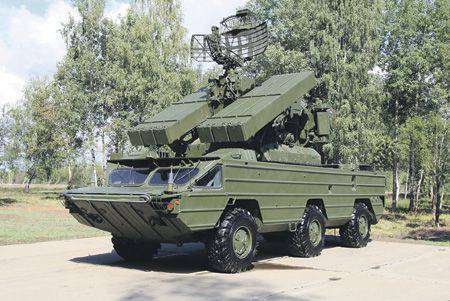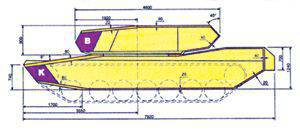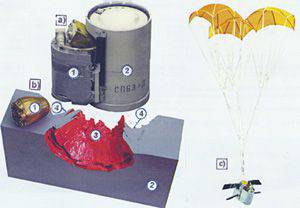Under fire reconnaissance and shock combat systems

The accelerated development of the damaging effect of anti-tank ammunition over the protection parameters of armored vehicles at the end of the last century revealed a serious lag in the methodology for creating promising tanks... Modern reconnaissance and strike combat systems (RUBS), which are a set of functionally interconnected reconnaissance, control and ammunition delivery complexes, make it possible to effectively hit the tanks of the opposing side already on the distant approaches to the line of contact and protect their tanks along the entire deployment route with simultaneous destruction aviation and ground anti-tank defenses of the enemy. Simply put, the basis of RUBS is made up of space reconnaissance and guidance systems, as well as carriers of high-precision weapons. And since the West is currently pursuing an aggressive policy towards Russia, it is logical to assume that first of all reconnaissance-strike systems will be needed to counter US and NATO tank brigades armed with Abrams and Leopards.
"ABRAMS" VULNERABLES
Tanks of developed countries compared with other types of military equipment of the ground forces have the greatest resistance to the effects of conventional and nuclear weapons. The modernization of the Abrams resulted in the appearance of the tank М1А2 SEP, the protection of which is based on a number of principles. For example, American experts believe that the frontal multi-layered defense of the tower and hull М1А2 SEP is not penetrated by armor-piercing sabot projectiles (BPS) of Soviet and Russian production. But they are much more afraid of domestic anti-tank guided missiles (ATGM) with high armor penetration. For this reason, an active protection complex (KAZ) is installed on М1А2 SEP, designed to repel attacks of the Kornet and Chrysanthemums. At the same time, the weak reservation of the “roof” of the Abrams resulted in high demands on the foreign KAZ for the defeat at the approach of the self-aiming (SPBE) and self-guided (SNBE) combat elements. At the same time, the Abrams KAZ provides protection against cumulative projectiles and rounds of hand-held anti-tank grenade launchers (RPGs), as well as aviation cumulative ammunition. But the weak protection of the "roof" and the bottom of the "Abrams" opens up certain opportunities for their defeat with the help of SPBE, SNBE, as well as with remote mining.
Tactical missiles, 9М55К1 to 300-mm MLRS Smerch missiles, as well as one-time bomb cassettes of RBK-500 SPBE-D, which contained fighting equipment contained SPEB "Motive", were created to destroy armored vehicles at long ranges in the Soviet Union. But in those days these developments did not reach the creation of the RUB, while the use of the RUB in the operational zone with a depth of 30 – 200 km (spaced from the contact line and located on the enemy’s territory) makes it impossible for Abrams to perform combat missions before reaching the front edge due to the defeat of a large number of tanks, as well as due to the breakdown of the nomination, deployment. The amount of our losses decreases accordingly.
RUBES AGAINST THE US TANK BRIDGES
In the tactical-technical assignment (TTZ) for the creation of a RUB with anti-tank weapons, an object of destruction must be presented, which can be recommended as a heavy brigade of the US Army. The basis of the fire brigade is the XNChX of the MxNUMX tanks, MxNumx, MxNumx The number of personnel of the brigade is 58 military. The brigade is accompanied by units of military air defense and electronic warfare (EW) in the air and ground performance. In the near future, along with the EW system, the Abrams brigade may also receive a microwave weapon with a high efficiency of disabling the electronics of various systems.
In order to identify the main features of RUB, we will consider its functioning according to the simplified scenario. The data on the movement parameters of the Abrams brigade, determined by the satellites of the Russian space reconnaissance, are sent to the command post, which has an automated control system that solves the following tasks: it determines the firing range of the brigade; carries out the organization of electronic suppression of electronics "Abrams" and military air defense, accompanying the brigade. It is advisable to counter air defense with an X-58E (and its newest modifications) aviation guided missile designed to destroy the radar. Electronic suppression is necessary to enhance the effect of high-precision ammunition.
At the end of last year, the press noted that the newest EW systems entering the troops could become a key factor in ensuring military superiority over the enemy. In this case, it can be conditionally accepted that domestic EW systems are capable of completely blocking the operation of electronic devices of the American brigade. It is under such conditions that the Smerch MLRS is fired - with missiles, the combat units of which are equipped with the SPBE "Motive". For the guaranteed decommissioning of the 50% armored vehicles of the heavy brigade, you need around 400 SPBE "Motive".
The presented scenario of the RUBM operation demonstrates the advantages of contactless forms of combat operations. Of course, the reality will differ from the hypothetical scenario. The real losses of the American heavy brigade may actually be less. This is also because the outdated element base purchased abroad is used in the development of the latest domestic electronic weapons, and the Russian element base does not always correspond to the level of world standards. Thus, there is a high degree of risk of low-quality EW samples received by troops. At the same time, it should be added that the NATO countries will never sell the newest and most promising electronics elements to Russia, especially in view of the complicated international military and political situation.
NEED A NEW TANKING METHODOLOGY

The creation of a new methodology for domestic tank building is due to the emergence of modern forms of hostilities - contact and non-contact wars using high-performance anti-tank weapons (PTS). Of greatest interest is the combat stability of our promising tank under the influence of the enemy's RUB. It is also important to pay attention to the fact that the new methodology should have a strategic focus on the creation of a promising tank, and not descend to the next modernization.
The main provisions for creating a new methodology for tank construction were published several years ago in an article by Valery Grigoryan, General Director of the Scientific and Research Institute of Steel, “Tank protection is an anachronism or a vital necessity?”, In which he found that under the conditions of superiority of the anti-tank means of entering the NATO RUBUS to protect tanks cannot provide reliable armor protection. This article also outlined the prerequisites and practical recommendations for creating a methodology that would allow the creation of promising tanks. But over the years 13, Russian tank builders did not have time to discuss this important issue. Creation of tanks continues according to the old methodology: weak armor protection and ineffective armament.
The protection of armored vehicles with paints with anti-icing effect, radio-absorbing and deactivating (reducing radiation contamination) can be attributed to the tank's own protection. But most likely, these coatings will not have an adequate effect on the destructive capabilities of the American JAGM anti-tank guided missile with a three-mode seeker, which provides the possibility of radar, infrared or semi-active laser targeting.
Valery Grigoryan paid much attention to the issue of tank visibility in relation to their detection by various types of weapons. It is necessary to apply large-scale efforts to reduce the visibility of combat vehicles by radar and space reconnaissance satellites, since further ignoring of this factor makes the maintenance of tank fleets senseless because of their inability to conduct any serious military operations.
Domestic tank builders claim that tanks remain the main vehicle for conducting close combat and breaking through enemy defenses (NVO No. 14, 2015 year). But the need to ensure that our tanks overcome the enemy's RUBS and the specialists of the Main Automobile and Armored Directorate (GABTU) and the same tank builders did not pay enough attention. If we imagine our tank brigade, making a march in the operational zone to the leading edge to break through the enemy defense, then the following situation is possible. The enemy inflicts an electronic strike on the brigade, followed by a fire strike, which is guaranteed to end with great losses for us. In other words, most of our tank brigade does not get to the front edge. In this case, there is no need to speak about any close combat and breakthrough at all. This example demonstrates the need to provide a tank brigade with new methods of combat using new weapons.
Due to the advanced development of the damaging effect of foreign anti-tank weapons, which far exceeds the parameters for the own defense of domestic tanks, the need arises to increase the effectiveness of group defense of tank brigades. At the same time, it is necessary to organize the application of electronic and fire strikes on the enemy's RUB, by the units of the Ground Forces and Aviation. All this should be reflected in the tactical and technical requirements of the GABTU issued to tank builders and other organizations involved in the creation of a promising tank.
Today, tank builders use the technique (see “NVO” No. 37, 2012 year) 40-year-old, in which the indicator of the military-technical level (VTU) is determined by multiplying the indicators of firepower (КХNUMX), security (КЗ), mobility (КП) and operational capabilities (CE), that is, VTU = К0хКЗхКПхКЭ. The methodology of VNIItransmash, JSC, according to VTU, takes into account only a generalized description of the main combat parameters of tanks. At the same time, this technique masks the unsatisfactory protection of tanks, which can be enhanced by group and collective protection.
GROUP PROTECTION
In the above-mentioned article, Valery Grigoryan believes that in addition to the tank's own protection (dynamic protection, armor, active protection complex) it is necessary to create group and collective protection, which can be used short-range anti-aircraft missile systems (SAMs) of short and medium range. Otherwise, in the conditions of the changed forms of hostilities and new anti-tank weapons of the enemy, the survival rate of the promising tank will be small. As a group of protection can be used short-range air defense systems "Tor-М1" (and its upgraded version of "Tor-М2Е"), Strela-10М3, Osa-AKM, as well as medium-range air defense systems . But are these complexes ready to ensure the defense of the tank brigade not only from anti-tank carriers (airplanes and helicopters), but also from long-range small-scale guided munitions?
It should be noted that the group protection of tank units attention was paid even in Soviet times. Then the Strela-10М3 and Osa-AKM short-range anti-aircraft missile systems (ZRK) were created, designed to protect motorized rifle units on the march and in various types of combat. These complexes carried out the defeat of fighters and helicopters in the near zone. The strike zone of the Strela-10М3 complex was 0,8 – 5 km in range and 0,01 – 3,5 km in height, Osa-AKM complex in 1,5 – 10 km and 0,05 – 5 km, respectively, and Tor-M1 complex - 1,5 – 12 km and 0,01 – 6 km. At the same time, the probability of a fighter hitting a single anti-aircraft missile for the Strela-10М3 complex was 0,1 – 0,5, for the Osa-AKM complex - 0,4 – 0,96, and for the Tor-М1 complex - 0,45 – 0,8. A Osa-AKM complex could hit a helicopter with a missile system with probability 0,24 – 0,76.
However, to date, aviation self-guided anti-tank weapons began to have an increased range, which allowed these carriers not to enter the zone of destruction of the air defense system. In this case, the Strela-10М3 and Osa-AKM air defense missile systems will be unable to combat many long-range small-size anti-tank ammunition. In general, to combat new long-range ammunition requires a revision of the creation of short-range air defense systems.

As is known, in the United States much attention is paid to the development of long-range ATGMs. So, in 2016, the fourth generation JAGM ATGM will be adopted by the American aircraft and helicopters. The maximum firing range for this missile will be 16 km for helicopters and 28 km for aircraft. JAGM will be equipped with a three-mode homing, which will provide the possibility of radar, infrared or semi-active laser targeting. This rocket has a tandem warhead with 1200 mm armor penetration. The JAGM missile will be replaced by the AGM-65 “Maverick” missiles, as well as the AGM-114 “Hellfire” and BGM-71 “Toy” missiles. It is planned to manufacture a JAGM rocket in the amount of 50 thousand. All this, of course, must be considered when creating a group defense of our tanks.
It is obvious that the probabilities of hitting airplanes and helicopters presented in the table will not correspond to the probabilities of hitting long-range high-speed, small-sized ammunition. Their probability of defeat will be close to zero.
Recently, the company IEMZ “Kupol” reported (see “NVO” No. 30, 2015 year) on the modernization of the Osa-AKM1 anti-aircraft missile system, which was to increase reliability and noise immunity (due to updating the outdated element base), due to which extended the life cycle of the complex for another 10 – 12 years. At the same time, the ability of the complex to hit small sized non-speed targets was achieved. These achievements, obtained through the modernization of the complex, are based on the unsubstantiated claims of the author of the article, who deviated from the established methodology for the development of such weapons. The author has passed over in silence the choice of foreign high-speed ATGS SPBE and SNBE as standard targets. The article unreasonably simplified the approach when replacing a foreign element base with domestic samples. The statement about the 12-year-old life cycle of the Osa-AKM1 anti-aircraft missile system sounds awkward. It is known that our lag in the element base is at least 10 years, so that in relation to this case it is useless to talk about any life cycle.
VICTORY PRICE
Only the improvement of the tank construction methodology with the solution of the problems of armaments, group and collective defense with the simultaneous creation of the RUBES will allow to bring the Russian tank fleet in combat effectiveness to the first place. It is under such conditions that the dream of domestic tank builders can be realized in order to break through any defense of any enemy.
To overcome considerable distances to the front edge, as well as to break through the defenses of our tank brigade, a powerful electronic strike will be required against the enemy, as a result of which he will be "blind", "deaf" and uncontrollable. Then a fire strike is made on the reconnoitered bases of carriers of SPBE, SNBE and anti-tank weapons of the front edge. That is, without the active support of the RUB, even promising domestic tanks will not be able to operate effectively in modern combat conditions.
Information